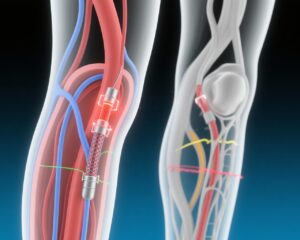Highlight
- Orforglipron, a once-daily oral small-molecule GLP-1 receptor agonist, significantly reduces glycated hemoglobin levels in patients with early type 2 diabetes over 40 weeks.
- It induces meaningful weight loss in adults with obesity or overweight conditions without diabetes, showing dose-dependent efficacy up to 14.7% weight reduction.
- The drug demonstrates a favorable safety profile consistent with known GLP-1 receptor agonist class effects, mainly mild-to-moderate gastrointestinal adverse events.
- Orforglipron offers the convenience of oral administration, which may improve treatment adherence compared to injectable GLP-1 receptor agonists.
Study Background and Disease Burden
Type 2 diabetes mellitus (T2DM) and obesity are interconnected global health challenges with substantial morbidity and mortality. T2DM prevalence continues to increase, driven mainly by rising obesity rates. Effective early glycemic control is paramount to reduce progression and complications of diabetes, yet many patients struggle with therapy adherence, especially when treatments require injections.
Glucagon-like peptide-1 receptor agonists (GLP-1 RAs) have become pivotal in T2DM management due to their potent glucose-lowering effects coupled with weight loss benefits. However, the peptide nature of most GLP-1 RAs necessitates injectable delivery, which can limit patient acceptance and adherence.
Orforglipron is a novel, small-molecule, nonpeptide GLP-1 receptor agonist administered orally, representing a significant therapeutic advancement. Its development addresses the unmet need for effective, well-tolerated oral agents for early T2DM and obesity management. Nevertheless, comprehensive clinical data on its efficacy and safety are critical to its integration into clinical practice.
Study Design
Two pivotal clinical trials assessed orforglipron’s efficacy and safety.
1. ACHIEVE-1 Trial (Phase 3, T2DM): This was a randomized, double-blind, placebo-controlled study including 559 adults with early T2DM controlled by diet and exercise alone. Participants had baseline glycated hemoglobin (HbA1c) levels between 7.0% and 9.5%, and a body mass index (BMI) ≥23.0 kg/m². They were randomized 1:1:1:1 to receive orforglipron at 3 mg, 12 mg, or 36 mg doses or placebo once daily for 40 weeks. The primary outcome was change in HbA1c at week 40; a key secondary endpoint was percent change in body weight.
2. GZGI Trial (Phase 2, Obesity): This randomized, double-blind study involved 272 adults with obesity (BMI ≥30) or overweight plus at least one weight-related comorbidity without diabetes. Subjects were randomized to four dose levels of orforglipron (12, 24, 36, or 45 mg) or placebo once daily for 36 weeks. The primary endpoint was percent change in body weight at week 26; weight change at week 36 was a key secondary endpoint.
Key Findings
Glycemic Control in Early Type 2 Diabetes (ACHIEVE-1):
– At baseline, mean HbA1c was 8.0%.
– At 40 weeks, mean HbA1c reductions were dose-dependent: -1.24% with 3 mg, -1.47% with 12 mg, and -1.48% with 36 mg, compared to -0.41% with placebo.
– All orforglipron doses demonstrated statistically significant superiority to placebo (P<0.001), with mean differences from placebo ranging from -0.83 to -1.07 percentage points.
– Final HbA1c values ranged from 6.5% to 6.7% with orforglipron treatment.
Weight Reduction in Early Type 2 Diabetes (ACHIEVE-1):
– Percentage body weight decreases at 40 weeks followed a dose-response pattern: -4.5% (3 mg), -5.8% (12 mg), and -7.6% (36 mg) compared to -1.7% for placebo.
Weight Management in Adults with Obesity (GZGI Trial):
– Baseline mean weight and BMI were 108.7 kg and 37.9 kg/m².
– At week 26, weight reductions ranged from -8.6% to -12.6% across orforglipron doses versus -2.0% in placebo.
– By week 36, reductions deepened to -9.4% to -14.7% (orforglipron) versus -2.3% (placebo).
– A ≥10% weight loss was achieved in 46–75% of orforglipron participants versus 9% of placebo.
– Improvements were observed in prespecified cardiometabolic parameters including blood pressure and lipid profiles.
Safety and Tolerability:
– The most common adverse events were gastrointestinal (nausea, vomiting, diarrhea), mostly mild to moderate during dose escalation.
– No severe hypoglycemia episodes were reported in the diabetes trial.
– Treatment discontinuation due to adverse events ranged from 4.4% to 7.8% with orforglipron vs. 1.4% with placebo in diabetes, and 10-17% in the obesity trial.
– Overall, safety profile was consistent with other GLP-1 receptor agonists.
Expert Commentary
Orforglipron represents a significant innovation as the first oral small-molecule GLP-1 receptor agonist showing robust efficacy in glycemic control and weight management. Its oral administration may overcome barriers related to injectable GLP-1 RA therapies, potentially enhancing patient adherence and earlier intervention in T2DM and obesity.
The glycemic reductions observed over 40 weeks—approximating or exceeding 1.4% HbA1c drop at higher doses—are clinically meaningful. Moreover, concomitant weight loss supports dual metabolic benefit, critical in the intertwined pathophysiology of diabetes and obesity.
The observed gastrointestinal adverse events are consistent with the GLP-1 RA class, typically transient and manageable with dose titration. The absence of severe hypoglycemia further supports orforglipron’s safety in early T2DM patients not on other glucose-lowering agents.
Limitations include the relatively short duration of follow-up for chronic disease and the exclusion of patients with advanced or insulin-treated diabetes, which may affect generalizability. Ongoing trials exploring longer-term outcomes, cardiovascular effects, and combination strategies will inform future positioning.
Conclusion
Orforglipron, a novel oral small-molecule GLP-1 receptor agonist, shows promising efficacy in lowering glycated hemoglobin and inducing weight loss in adults with early type 2 diabetes and obesity. Its safety profile aligns with the GLP-1 RA class, with a predominantly mild gastrointestinal side effect burden and no severe hypoglycemia reported.
As an oral agent, orforglipron may improve the accessibility and compliance of GLP-1 RA therapy, addressing unmet needs in early diabetes intervention and obesity management. Future research will clarify its long-term benefits and its role alongside established treatments.
References
1. Rosenstock J, Hsia S, Nevarez Ruiz L, et al; ACHIEVE-1 Trial Investigators. Orforglipron, an Oral Small-Molecule GLP-1 Receptor Agonist, in Early Type 2 Diabetes. N Engl J Med. 2025;393(11):1065-1076. doi:10.1056/NEJMoa2505669.
2. Wharton S, Blevins T, Connery L, et al; GZGI Investigators. Daily Oral GLP-1 Receptor Agonist Orforglipron for Adults with Obesity. N Engl J Med. 2023;389(10):877-888. doi:10.1056/NEJMoa2302392.



